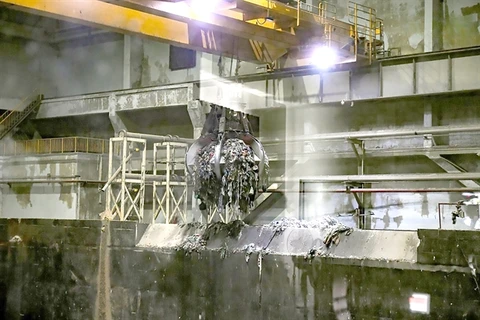
Hanoi (VNS/VNA) – The Hanoi People’s Council on December 12 approved a resolution to establish low-emission zones in the capital city.
Measures will primarily focus on transportation, including allowing vehicles that are environmentally friendly, not emitting pollutants and using clean and green energy.
Vehicles of priority or with circulation permits from authorities can operate within the low-emission zones.
Restrictions or bans can be applied for vehicles that do not meet the Euro emissions standards, specifically Euro 4 for cars and Euro 2 for motorcycles, in these zones during specific hours.
Proposals for fees and charges for pollution-emitting vehicles travelling in low-emission zones are expected to be put forward sometime in the future, while the first zones could come into force in 2025.
In addition, support policies will be proposed for residents in these zones, for organisations and businesses transitioning from fossil fuel-powered to environmentally friendly vehicles, as well as for investments into clean energy transportation infrastructure.
According to the document, the criteria to identify low-emission zones are locations belonging to emission-restricted and protected areas as stated in the capital’s Master Plan to 2030 with a vision to 2050; frequently experiencing serious traffic congestion according to Vietnam’s standards for urban roads (TCVN 13592:2022); with the average air quality (measured over at least one year prior) not meeting the National Technical Regulation on Air Quality (QCVN 05:2023/BTNMT) for key indicators: SO2, NO2, Total Suspended Particulate (TSP).
The low-emission zones must be planned for urban development with a priority for public transportation, or sufficient road infrastructure for appropriate traffic planning.
Authorities must also devise a plan to monitor and assess emission levels and emission reduction in these areas and to prepare for transportation mode transition.
The specific implementation roadmap states that low-emission zones will be piloted in Hoan Kiem and Ba Dinh districts from 2025 to 2030, while other localities are encouraged to implement a similar model.
From 2031 onwards, areas in the capital city that have one of the above criteria must implement the low-emission zone model.
Based on the above criteria, the district-level People’s Committees will develop a proposal for a low-emission zone, customised for the specific conditions and capacity of their locality.
The proposal for the low-emission zone must be published in the media for at least 30 days for the planned area, inviting feedback, in addition to comments from State management agencies responsible for environmental protection and transport.
A report from the Hanoi People's Council showed that the capital city is facing challenges in air pollution management and environmental protection with a widespread decline in air quality, which has significant impacts on public health.
To date, low-emission zones have been implemented in 320 cities across Europe as well as major cities in Asia such as Beijing (China), Seoul (the Republic of Korea) and Jakarta (Indonesia).
Prior to the issuance of the low-emission zone resolution, feedback was gathered from 30 districts and municipalities for the drafting process./.






















